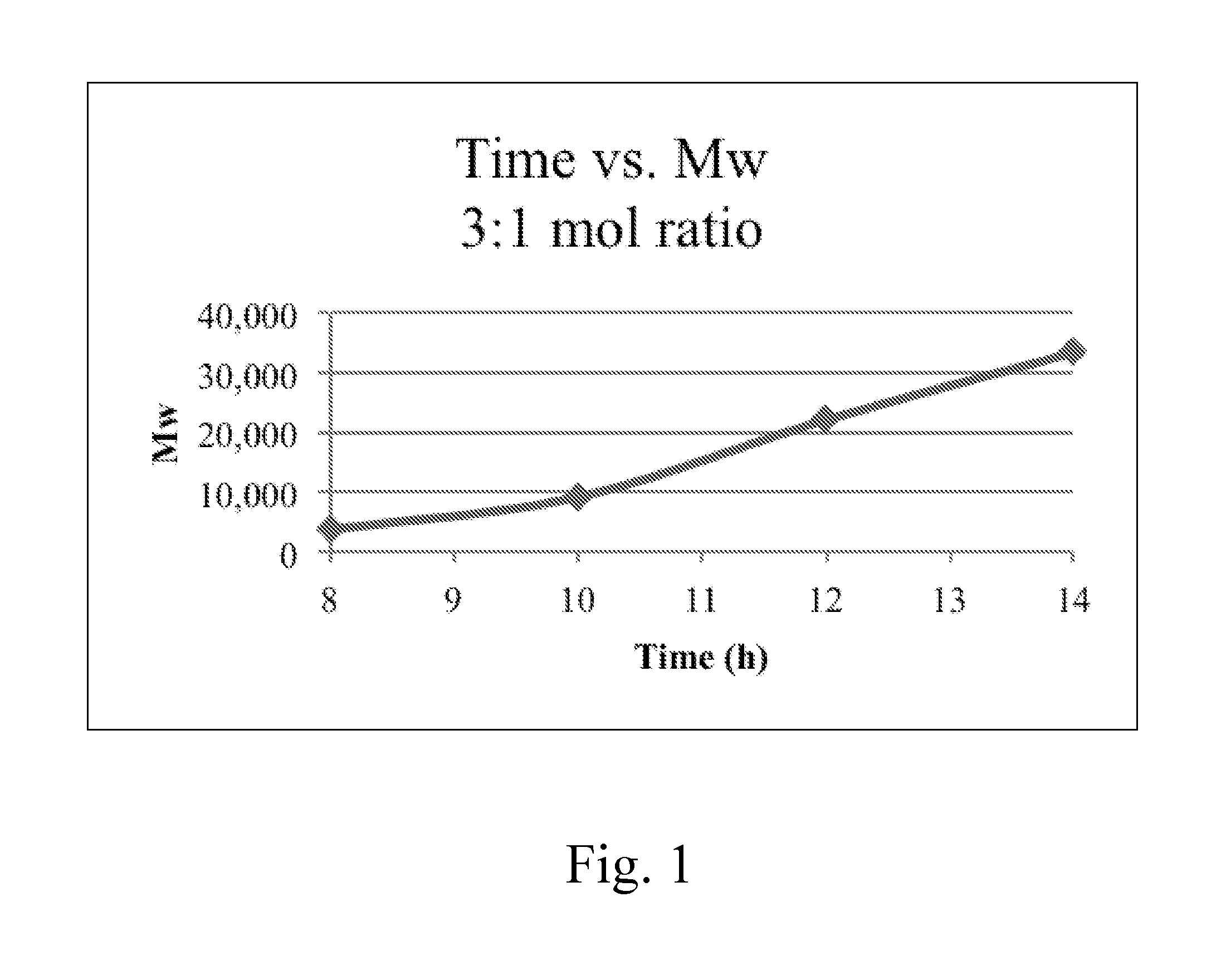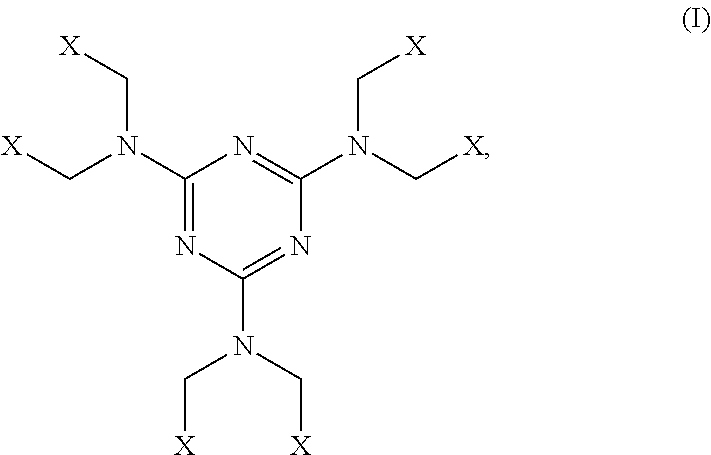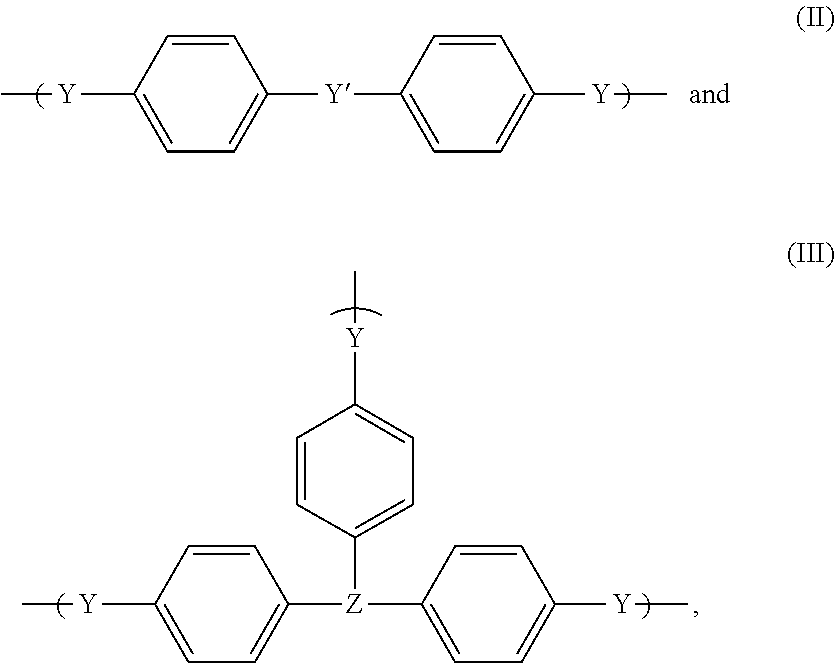All-organic high refractive index materials
a high refractive index, all-organic technology, applied in the field of polymer, can solve the problems of color materials, difficult to achieve using organic polymers, and difficult to add inorganic “fillers” into the polymer matrix, and achieve the effect of high refractive index layer
- Summary
- Abstract
- Description
- Claims
- Application Information
AI Technical Summary
Benefits of technology
Problems solved by technology
Method used
Image
Examples
example 1
Synthesis of Polymer 1—Comparative Example
[0051]The following was added to a round bottom flask fitted with a condenser: 8.00 grams (0.03195 mol) of 4,4′-thiobisbenzenethiol (“TBBT,” Sigma-Aldrich St. Louis, Mo.), 6.33 grams (0.0213 mol) of tris-(2,3-epoxypropyl)isocyanurate (“TEPIC,” Nissan Chemical, Tokyo, Japan), and 21.50 grams of cyclohexanone (Sigma-Aldrich St. Louis, Mo.). The mixture was heated to 80° C. and stirred for 16 hours. The resulting material was cooled to room temperature and soon became cloudy. The mixture was diluted with 35.82 grams of propylene glycol monomethyl ether (“PGME,” Ultra Pure Solutions, Inc., Castroville, Calif.) down to 20% solids and filtered.
[0052]A cured film was formed by spin coating the mixture on a silicon substrate at 1,500 rpm, followed by baking at 205° C. for 1 minute. Refractive index (RI) measurements were taken of the cured film on a VASE® M2000 ellipsometer, and the RI was measured at 1.74 at 400 nm.
example 2
Synthesis of a Series of Polymers
[0053]A series of 1.3:1, 1.6:1, 1.9:1, and 3.9:1 molar ratio TBBT:CYMEL® 303LF polymers were prepared. Each system was 50% solids in cyclohexanone, with catalytic loading of pTSA at 1% of the weight of TBBT. The polymerizations were heated to 80° C. for 3.5 hours.
[0054]The resulting mixture was diluted down to 3% by weight solids by adding additional cyclohexanone. A photoacid generator (CPI-6992, Aceto Corp., Port Washington, N.Y.) was added to the mixture at a loading of 2% by weight, based upon the total weight of the solids taken as 100% by weight.
[0055]Cured films were formed by spin coating the mixture on silicon substrates at 2,500 rpm, followed by baking at 220° C. for 2 minutes. All cured films were analyzed on a VASE® M2000 ellipsometer and were optically transparent in the visible region and had a refractive index of over 1.8 at 400 nm. The 3.9:1 (4:1) ratio had an RI of 1.85.
example 3
Synthesis of Polymer 2
[0056]The following ingredients were added to a jacketed reactor flask fitted with a condenser: 200 grams (798.72 mol) of TBBT, 124.601 grams (319.489 mol) of CYMEL® 303LF, 1.0 gram of pTSA, 389.52 grams of anisole (Sigma-Aldrich, St. Louis, Mo.), and 97.38 g n-butanol (Sigma-Aldrich, St. Louis, Mo.). The mixture diluted down from 40% solids to 15% solids by mixing in an additional 2,082.5 grams cyclohexanone.
[0057]The material was immersed in a dual-bed ion exchange system comprised of Ambersep™ 200 H Resin (ROHM & HAAS Chemicals LLC, Philadelphia, Pa.) and Amberlyst A26 (Sigma Aldrich, St. Louis, Mo.) for 4.5 hours. The resin beads were filtered off through 0.1-μm filter. The following ingredients were then added to the system: PAG (CPI-6992), at a loading of 8% by weight of the solids and Megaface R30N surfactant (DIC Corporation, Chiba, Japan), at a loading of 0.02% by weight of the solids.
[0058]Cured films were formed by spin coating the mixture on silicon...
PUM
| Property | Measurement | Unit |
|---|---|---|
| Fraction | aaaaa | aaaaa |
| Percent by mass | aaaaa | aaaaa |
| Percent by mass | aaaaa | aaaaa |
Abstract
Description
Claims
Application Information
 Login to View More
Login to View More - R&D
- Intellectual Property
- Life Sciences
- Materials
- Tech Scout
- Unparalleled Data Quality
- Higher Quality Content
- 60% Fewer Hallucinations
Browse by: Latest US Patents, China's latest patents, Technical Efficacy Thesaurus, Application Domain, Technology Topic, Popular Technical Reports.
© 2025 PatSnap. All rights reserved.Legal|Privacy policy|Modern Slavery Act Transparency Statement|Sitemap|About US| Contact US: help@patsnap.com



